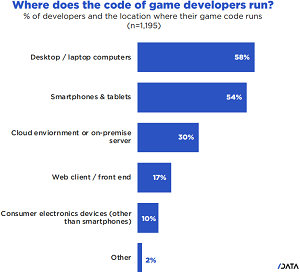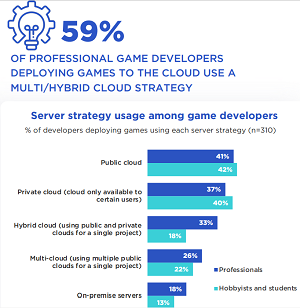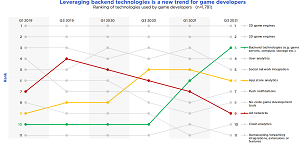News
Game Development/Deployment Heads to the Cloud
Developer-centric research firm SlashData published a quarterly report that illustrates the increasing importance of cloud computing in the development and deployment of games.
The 21st edition of the State of the Developer Nation report details Q3 2021 trends, based on a survey of more than 19,000 developers. In addition to the usual highlights concerning programming languages, 5G, IoT, machine learning/data science and so on, one of the report's main sections is technology in game development. Highlights here include:
- The percentage of developers deploying their games via the cloud rose by 10 percent in the last six months, the largest increase of any platform type.
- Of the professional game developers deploying their code to the cloud, 43 percent are using a multi/hybrid strategy.
- Backend technologies are now the third most used technology in game development, behind only 2D and 3D game engines.
- Professional game development requires more usage of backend technologies, with a majority of developers using storage/database technologies.
"The game development sector has long targeted on-device game deployment," the report says. "More than half of all game developers are writing code and deploying games for the usual suspects: personal computers and mobile devices. The percentage of developers deploying code for PCs saw a slight increase to 58 percent in the last six months, indicating that gaming on PC hardware is still a thriving market. However, the proportion of developers creating games that run in the cloud saw a slightly larger percentage increase in the last six months, rising to 30 percent.
 [Click on image for larger view.] Where does the code of game developers run? (source: SlashData).
[Click on image for larger view.] Where does the code of game developers run? (source: SlashData).
"Cloud gaming is arguably one of the most foundationally innovative trends in the game development sector. The increased usage and availability of smartphones with high-speed internet connections has paved the way for game developers to deploy their code to a game-configured server instead of a downloadable, platform-specific version. With less game-specific content to download and similar performance to on-device versions, both gamers and companies stand to benefit greatly from cloud gaming."
 [Click on image for larger view.] Server strategy usage among game developers (source: SlashData).
[Click on image for larger view.] Server strategy usage among game developers (source: SlashData).
The report indicates that multi/hybrid cloud solutions are getting more popular as game-makers seek to reduce single-provider dependencies, avoid vendor lock-in and enjoy associated cost optimizations.
"Cloud developers can either work with a single public, private, or on-premises server, or they can devise a strategy that uses a combination of these server types," the report says. "Our data shows that about 46 percent of game developers deploying their code to the cloud are now using a multi/hybrid cloud strategy. Further, we see a significant increase in multi/hybrid cloud deployment to 59 percent when we filter for professional game developers only. Though a multi/hybrid cloud strategy can be more complex, it's a popular approach for game developers when tackling one of cloud gaming’s biggest issues: latency. To reduce the amount of delay for users, game developers can leverage a multi/hybrid cloud approach that regionalizes players and directs their interactions to the closest server."
Cloud backend technologies -- the third bullet point in the list above -- are now No. 3 on the list, placing only behind 3D and 2D game engines.
 [Click on image for larger view.] Leveraging backend technologies is a new trend for game developers (source: SlashData).
[Click on image for larger view.] Leveraging backend technologies is a new trend for game developers (source: SlashData).
"Backend technology use by game developers has almost doubled in this timeframe, from 11 percent to 21 percent," the report says. "The growing trend of games being deployed in the cloud has partially fuelled the growth of backend technologies, especially among professional developers."
Besides the gaming/cloud angle, other highlights of the report touching upon programming languages, careers, 5G, data science and more include:
- JavaScript is the most popular programming language by a wide margin, with nearly 16.5M developers using it globally.
- Upwards of 2.5M developers joined the JavaScript community in the past six months alone.
- Rust has grown faster than any other language in the last 24 months.
- Greater China is the epicenter of the 5G revolution for software developers. In this region, 82 percent of developers are interested in, learning about, or working with 5G technologies.
- Manufacturing, smart cities and digital twin technologies are the IIoT markets in which we find most IIoT professionals working with 5G.
- Many developers know their worth -- just one in 10 developers say that nothing would make them leave their current employer.
- Developers consider short-and long-term success when deciding to change employers.
- Just one in 10 data science/machine learning developers are involved end-to-end in the DS/ML workflow and end-to-end involvement is decreasing.
- More than two-thirds (68 percent) of developers building apps for third-party ecosystems identify as a professional.
- Eastern European developers are the most concerned with compensation.
- Experienced developers are the most content in their jobs.
About the Author
David Ramel is an editor and writer at Converge 360.